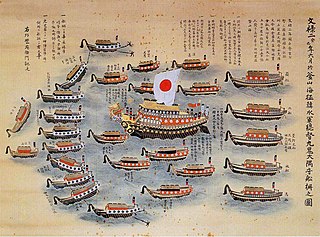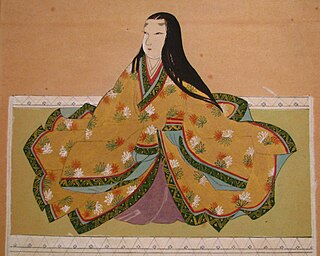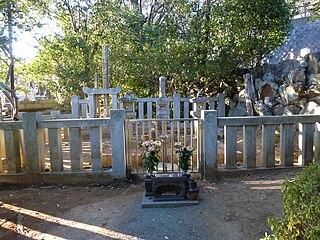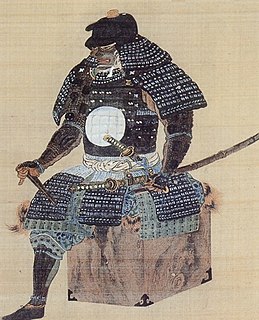 W
WA list of female castellans in Japanese history.
 W
WAshikaga Mochiuji was the Kamakura-fu's fourth Kantō kubō during the Sengoku period in Japan. During his long and troubled rule the relationship between the west and the east of the country reached an all-time low. Kamakura was finally attacked by shōgun Ashikaga Yoshinori and retaken by force. Mochiuji and his eldest son Yoshihisa killed themselves to escape capture.
 W
WLady Aya was a Japanese noble woman from the Sengoku period. She was the half-sister of Japanese warlord Uesugi Kenshin. She was also the mother of Uesugi Kagekatsu and the first wife of Nagao Masakage Aya is best known for her role in events before and after the Siege of Otate; she lamented the Uesugi civil war for succession after Kenshin's death and refused to support either heir.
 W
WAzai Nagamasa was a Japanese daimyō of the Sengoku period. He was the brother-in-law and enemy of Oda Nobunaga. He was head of the Azai clan seated at Odani Castle in northern Ōmi Province and married Nobunaga's sister Oichi in 1564, fathering her three daughters – Yodo-dono, Ohatsu, and Oeyo – who became prominent figures in their own right. Nagamasa became one of Nobunaga's enemies in 1570 due to the Azai alliance with the Asakura clan, and fought against Nobunaga at major battles including the Battle of Anegawa. Nagamasa and his clan were destroyed by Nobunaga in August 1573, and he committed seppuku during the Siege of Odani Castle.
 W
WEmperor Go-Nara was the 105th Emperor of Japan, according to the traditional order of succession. He reigned from June 9, 1526 until his death in 1557, during the Sengoku period. His personal name was Tomohito (知仁).
 W
WHosokawa Tama (細川玉), usually referred to as Hosokawa Garasha (細川ガラシャ), was a member of the Akechi family. aristocrat from the Sengoku period. She was the daughter of Akechi Mitsuhide, the wife of Hosokawa Tadaoki, and a Christian convert. Gracia is best known for her role in the Battle of Sekigahara, she was considered to be a political hostage to the Western army led by Ishida Mitsunari. She reneged on committing suicide (seppuku) because of their Christian faith, breaking the code of conduct imposed on women of the samurai class.
 W
WIrohahime was a Japanese noble lady and aristocrat from the Sengoku period and Edo period. She was the first daughter of Date Masamune and Megohime, as well as the wife of Matsudaira Tadateru, the sixth son of Tokugawa Ieyasu. Her Buddhist name is Tenrin'in (天麟院).
 W
WOkuni was a Japanese shrine maiden who is believed to have invented the theatrical art form of kabuki. Thought to have begun performing her new art style of "kabuki" theatre in the dry riverbed of the Kamo River in Kyoto, Okuni's performances gained immense popularity, and were known for their performances, who were often lower-class women Okuni had recruited to act in her all-female troupe.
 W
WJukei-ni was a Japanese noble lady who acted as the power behind the throne or de facto daimyo of the Imagawa clan during the Sengoku period. She was born in the aristocrat Nakamikado Family of Kyoto. Jukei-ni was the wife of Imagawa Ujichika and mother of Imagawa Ujiteru, Imagawa Yoshimoto and Zukei-ni. She acted as guardian and advisor for Ujichika, Ujiteru, Yoshimoto and her grandson Imagawa Ujizane. Jukei-ni is also known as ''Onna Daimyo'' and "Amamidai", once proclaimed that she would "protect Imagawa to her grave".
 W
WLady Kasuga was a Japanese noble lady and politician from a prominent Japanese samurai family of the Azuchi–Momoyama and Edo periods. Born Saitō Fuku (斉藤福), she was a daughter of Saitō Toshimitsu. She was the wet nurse of the third Tokugawa shōgun Iemitsu. Lady Kasuga was one of the best politicians in the Edo period. She stood in front of negotiations with the Imperial Court and contributed to the stabilization of the Tokugawa Shogunate.
 W
WKatō Tsune (加藤つね), Shōju-in (松寿院) or Otsune (お安) was a Japanese female warrior (Onna-bugeisha) from the Sengoku period. She came from the Katō clan and was the wife of the samurai warlord Okumura Nagatomi. She helped her family and the Maeda troops resist Sassa Narimasa at the Siege of Suemori Castle by providing food and medical aid to injured warriors and arming herself with a naginata to fight beside them during the conflict.
 W
WKitabatake Tomonori was the master of south Ise Province and ruled from Kitabatakeshi Jōkan. He learned swordplay from Tsukahara Bokuden so he was famous as a skilled sword man. His territory was invaded by Oda Nobunaga in 1569. He surrendered and adopted Nobunaga’s second son Oda Nobukatsu.
 W
WKuki Yoshitaka was a naval commander during Japan's Sengoku Period, under Oda Nobunaga, and later, Toyotomi Hideyoshi. He was also the ninth headmaster of the Kuki family's school of martial arts, Kukishin-ryū and thus a very skilled warrior.
 W
WTeruhime or Kushihashi Teru was a Japanese noble lady and aristocrat from the Sengoku period. She was Kuroda Yoshitaka's only wife. Daughter of Kushihashi Koresada and the foster daughter of Kodera Masamoto, she was the princess of Shikata castle in Harima Province. In the Battle of Sekigahara, Ishida Mitsunari planned to take her as a political hostage, but with the help of Toshiyasu Kuriyama, Tahei Mori and others retainers, she was able to hide and escape.
 W
WKyōgoku Tatsuko (京極竜子) was a Japanese woman who lived from the Sengoku period to the early Edo period. She was the younger sister of Kyōgoku Takatsugu. She was first the wife of Wakasa daimyō Takeda Motoaki, but after his death she became Toyotomi Hideyoshi's concubine. Her cousin, Chacha, was also a concubine and both of them were best friends. Hideyoshi granted her the name Lady Matsunomaru (松の丸殿).
 W
WMaeda Toshimasa was a Japanese daimyō of the Sengoku period to the early Edo period, belonging to the Maeda clan. He was the second son of Maeda Toshiie and Maeda Matsu.
 W
WMaeda Toshinaga was a Sengoku period Japanese samurai and the second early-Edo period daimyō of Kaga Domain in the Hokuriku region of Japan, and the 3rd hereditary chieftain of the Maeda clan. He was the eldest son of Maeda Toshiie. His childhood name was "Inuchiyo" (犬千代).
 W
WMegohime, or Yoshihime was a Japanese noble lady and aristocrat from the Azuchi–Momoyama period to the early Edo period. She is the daughter and only child of Tamura Kiyoaki, the lord of Miharu Castle, and Okita, daughter of Sōma Akitane. She was also the wife of Date Masamune. She was also known as Lady Tamura (田村御前). After fulfilling her pravrajya, her posthumous Buddhist name was Yōtokuin (陽徳院).
 W
WMizoguchi Hidekatsu was a Sengoku period samurai and early Edo period daimyō of Shibata Domain in Echigo Province, Japan. His courtesy title was Hōki-no-kami, and his Court rank was Junior Fifth Rank, Lower Grade.
 W
WMizoguchi Nobukatsu was a Sengoku period samurai and the 2nd daimyō of Shibata Domain in early Edo period Echigo Province, Japan. His courtesy title was Hōki-no-kami, and his Court rank was Junior Fifth Rank, Lower Grade.
 W
WMori Ranmaru , also known as Mori Naritoshi, was the son of Mori Yoshinari, and had 5 brothers in total, from the province of Mino. He was a member of the Mori Clan, descendants of the Seiwa Genji.
 W
WMyōrin (妙林) or Yoshioka Myorinni (吉岡妙林尼) was a late-Sengoku period female warlord onna-bugeisha. She was the wife of Yoshioka Akioki a samurai warlord, and served Otomo clan in Bungo. She was the heroic woman who defended the Otomo clan in the Kyūshū campaign against Shimazu's army. Her contributions to the Kyushu campaign were so significant that they completely changed the course of history and she was highly praised by Japan's most powerful man at the time, Toyotomi Hideyoshi. Later, she was named ''Guardian of Tsusuraki'', an honorary title due to her heroic acts.
 W
WNanbu Nobunao was a Sengoku period Japanese samurai, and daimyō and the 26th hereditary chieftain of the Nanbu clan. His courtesy title was Daizen Daibu, and his Court rank was Junior Fourth Rank, Lower Grade.
 W
WKōdai-in (高台院), formerly known as Nene (ねね), One (おね), Nei (ねい), was an aristocrat and Buddhist nun, founder of the temple Kōdai-ji in Kyoto, Japan. She was formerly the principal samurai wife of Toyotomi Hideyoshi under the name of Toyotomi Yoshiko . When she rose in higher political status, she took the title of "Kita no mandokoro".
 W
WLady Nō , also known as Kichō (帰蝶), was the legal wife of Oda Nobunaga, a major daimyō during the Sengoku period of Japanese history. Her proper name was Kichō, but since she came from Mino Province, she is most commonly referred to as Nōhime. She was renowned for her beauty and cleverness.
 W
WNumata Jakō also known as Hosokawa Maria was a Japanese noble lady of the Sengoku period. She was the wife of Hosokawa Fujitaka and mother of Hosokawa Tadaoki. She was best known for fighting in the Siege of Tanabe and for accompanying the Hosokawa clan in the Tokugawa vanguard to clash with Shima Sakon's forces during the Sekigahara campaign.
 W
WOeyo (於江与), Gō (江), Ogō (小督) or Satoko (達子) : 1573 – September 15, 1626) was a prominently-placed female figure in late-Sengoku period. She was daughter of Oichi and the sister of Yodo-dono and Ohatsu. When she rose in higher political status during the Tokugawa shogunate, she took the title of "Ōmidaidokoro". Following the fall of the Council of Five Elders, Oeyo and her sisters were key figures in maintaining a diplomatic relationship between the two most powerful clans of their time, Toyotomi and Tokugawa. Due to her great contributions to politics at the beginning of the Edo period she was posthumously inducted into the Junior First Rank of the Imperial Court, the second highest honor that could be conferred by the Emperor of Japan.
 W
WEmperor Ōgimachi was the 106th Emperor of Japan, according to the traditional order of succession. He reigned from October 27, 1557, to his abdication on December 17, 1586, corresponding to the transition between the Sengoku period and the Azuchi–Momoyama period. His personal name was Michihito (方仁).
 W
WOhatsu (お初) or Ohatsu-no-kata (お初の方) was a prominently placed figure in the late Sengoku period. She was daughter of Oichi and the sister of Yodo-dono and Oeyo. Alongside her sisters, she was active in the political intrigues of her day. Ohatsu's close family ties to both the Toyotomi clan and the Tokugawa clan uniquely positioned her to serve as a conduit between the rivals. She acted as a liaison until 1615 in Siege of Osaka, when the Tokugawa eliminated the Toyotomi.
 W
WOichi was a female historical figure in the late Sengoku period. She is known primarily as the mother of three daughters who became prominent figures in their own right – Yodo-dono, Ohatsu and Oeyo. Oichi was the younger sister of Oda Nobunaga; and she was the sister-in-law of Nōhime, the daughter of Saitō Dōsan. She was descended from the Taira and Fujiwara clans.
 W
WŌmandokoro was the mother of the Japanese ruler Toyotomi Hideyoshi.
 W
WŌtomo-Nata Jezebel or Lady Nata was a Japanese noble woman from the Sengoku period. Daughter of Nata Akimoto, she was a high priestess of Usa Jingū. She was the first wife of Christian daimyo Ōtomo Sōrin. She actively resisted against the Jesuit mission in Japan and the spread of Christianity in Kyushu.
 W
WRikei was a Japanese noble lady, calligrapher, poet and scholar. She was the eldest daughter of Katsunuma Nobutomo, a samurai of the Sengoku period. She lived as a nun on Daizen-ji temple at Mount Kashiwao and is most notable for her military history, Rikei-ni no Ki, or "Nun Rikei’s Account."
 W
WLady Saigō, also known as Oai, was the first consort and trusted confidante of Tokugawa Ieyasu, the samurai lord who unified Japan at the end of the sixteenth century and then ruled as shōgun. She was also the mother of the second Tokugawa shōgun, Tokugawa Hidetada. Her contributions were considered so significant that she was posthumously inducted to the Senior First Rank of the Imperial Court, the highest honor that could be conferred by the Emperor of Japan.
 W
WLady Sanjō was a Japanese woman and aristocrat of the Sengoku period. She was the wife of the daimyō, Takeda Shingen. She was the daughter of Sanjō Kinyori, a court noble of Kyoto; her sisters married Hosokawa Harumoto and Honganji Kennyo, respectively. Lady Sanjō married Shingen at age 16. She gave birth to three sons and two daughters.
 W
WSatake Yoshinobu was a daimyō in Sengoku period and early Edo period Japan under the under the Tokugawa shogunate and the 19th head of the Satake clan and 1st daimyō of Kubota Domain in Dewa Province. His courtesy title was Sakonoeshōshō, later Ukyō-dayū and Jijū and his Court rank was Junior Fourth Rank, Upper Grade.
 W
WSenhime (千姫), or Lady Sen, was the eldest daughter of the shōgun Tokugawa Hidetada and later the wife of Toyotomi Hideyori. She was remarried to Honda Tadatoki after the death of her first husband. Following the death of her second husband, she later became a Buddhist nun under the name of Tenjuin (天樹院).
 W
WLady Shirai was a Japanese noble lady and aristocrat from the Sengoku period. She was born to the Nagao clan in Shirai, who were head retainers to the Uesugi clan in Kantō. She was the wife of Narita Nagayasu, the lord of Oshi castle in Musashi. She is also thought to be either the daughter or granddaughter of Nagao Kageharu. Lady Shirai was a retainer of the Ashikaga Shogunate, fought and died during the Incident of Kyoto in 1565, when Ashikaga Yoshiteru was killed.
 W
WThe Sōma Nakamura Domain was a minor feudal domain under the Tokugawa shogunate of Edo period Japan based in southern Mutsu Province in what is now part of the Hamadōri region of modern-day Fukushima Prefecture. It was ruled for the entirety of its history by the Sōma clan. It was centered at Sōma Nakamura Castle in what is now part of the city of Sōma. The domain was also known as Sōma Domain or Nakamkura Domain .
 W
WTachibana Ginchiyo was head of the Japanese Tachibana clan and onna-bugeisha during the Sengoku period. She was the daughter of Tachibana Dōsetsu, a powerful retainer of the Ōtomo clan. Because Dosetsu had no sons, he requested that Ginchiyo be made family head.
 W
WTanegashima Tokitaka was a Japanese daimyō of the Sengoku period, the 14th head of the Tanegashima clan. He is known for having first established contact with the Europeans, and producing the first European type firearms of Japan.
 W
WTokuhime was a princess during the Sengoku and Edo periods of Japanese history. She was the second daughter of Tokugawa Ieyasu; her mother was Lady Nishigori (西郡の方), one of Ieyasu's concubines. Tokuhime was also known as Ofū, Tomiko, Harima-gozen, and Ryōshō-in.
 W
WTozawa Masamori was the 1st daimyō of Shinjō Domain in Dewa Province, Japan. His courtesy title was Ukyō-no-kami, and his Court rank was Junior Fifth Rank, Lower Grade.
 W
WLady Tsukiyama or Tsukiyama-dono (築山殿) was a Japanese noble lady and aristocrat from the Sengoku period. She was the chief consort of Tokugawa Ieyasu, the daimyō who would become the founder and first shōgun of the Tokugawa shogunate. She was the mother of Ieyasu's first child, Kamehime, and gave birth to Ieyasu's heir apparent, Matsudaira Nobuyasu. As principal consort, Tsukiyama led many of the political achievements of the former Matsudaira clan. She was an important figure at the beginning of Ieyasu's career, who later led to the beginning of Tokugawa Shogunate. She is best known for possibly initiating a conspiracy against Oda Nobunaga; the veracity of this event remains one of the greatest mysteries of the Sengoku period, known as the Nobuyasu Incident.
 W
WYuki no Kata (ゆきの方) or Oyuki (おゆき), was a Japanese female warrior (Onna-bugeisha) from the Sengoku period. She was the wife of Tomita Nobutaka, an officer of Toyotomi Hideyoshi. Her birth and death are not recorded. Portrayed in current records as beautiful and highly skilled warrior, she defended the Anōtsu castle in the Battle of Sekigahara.